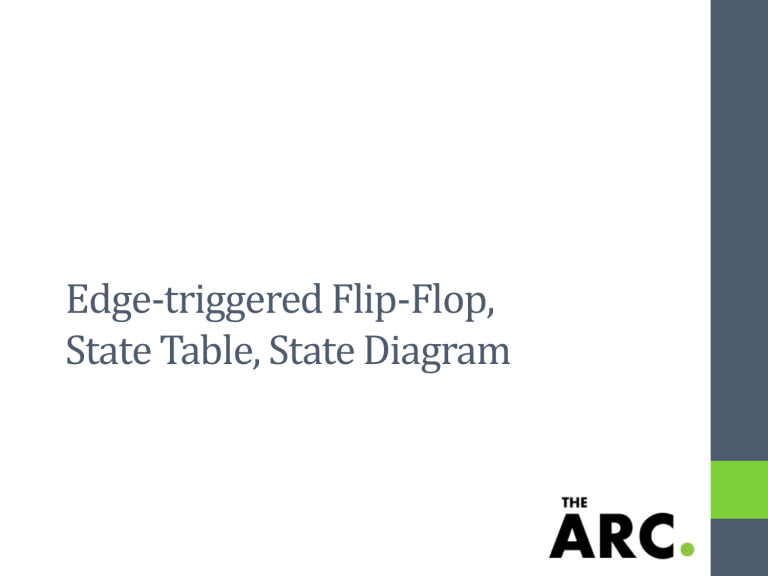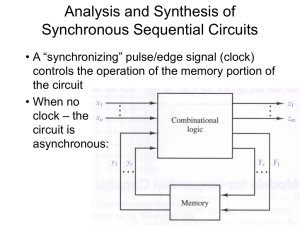Edge-triggered Flip-Flop, State Table, State Diagram

Edge-triggered Flip-Flop,
State Table, State Diagram
Edge-triggered Flip-Flop
• Contrast to Pulse-triggered SR Flip-Flop
• Pulse-triggered: Read input while clock is 1, change output when the clock goes to 0. What happens during the entire HIGH part of clock can affect eventual output.
• Edge-triggered: Read input only on edge of clock cycle (positive or negative)
• Example below: Positive Edge-Triggered D Flip-Flop
• On the positive edge (while the clock is going from 0 to 1), the input D is read, and almost immediately propagated to the output Q. Only the value of D at the positive edge matters.
D Q
Clock
D
C
S
C
R
Q
Symbol
• Symbol of edge-triggered D flip-flop
D
C
Positive-edge triggered
D
C
Negative-edge triggered
Flip-Flop Timing
• Set-up time: t s
• Input needs to be stable before trigger
• Hold time: t h
• Input needs to be stable after trigger
• Propagation delay: t p
• Some delay from trigger to output change
• Example: Negative edge triggered flip-flip
Clock t s t h t p
Sequential Circuit Description
• Input Equations
• State Table
• State Diagram
• We’ll use the following example
X
Sequential Circuit Description
D
C
A
A
Clock
D
C
B
B
Y
X
Sequential Circuit Description
Next state Present state input
D
C
A
A
D
C
Clock
At the clock trigger, the next state will be read and transferred to the present state
B
B
Y output
Input Equations
A next
= A present
X + B present
X
B next
= A’ present
X
Y = (A present
+ B present
)X’
Next state in terms of input and present state
Output in terms of input and present state
State Table
Present State Input Next State Output
A B X A B Y
0 0 0 0 0 0
0 0 1 0 1 0
0 1 0 0 0 1
0 1 1 1 1 0
1 0 0 0 0 1
1 0 1 1 0 0
1 1 0 0 0 1
1 1 1 1 0 0
State Diagram
0/0
1/0
0/1
00
10
01
0/1
0/1
1/0
1/0
11
1/0
Mealy and Moore Models
• Preceding Example: Output depends on present state and input.
This is called the Mealy Model
• Another kind of circuit: Output only depends on present state. This is called the Moore Model
Example of Moore Model
X
Y
A
D
C
Z
A next
= A present
+ XY
Z = A present
Clock
X Y A present
A next
0 0 0 0
0 0 1 1
0 1 0 0
0 1 1 1
1 0 0 0
1 0 1 1
1 1 0 1
1 1 1 1
00,01,10
0/0
11
1/1
00,01,10,11
Moore Model
Inputs Some
Combinational
Circuit
Flip-flops
Some
Combinational
Circuit
Outputs
Mealy Model
Inputs Some
Combinational
Circuit
Flip-flops
Some
Combinational
Circuit
Outputs
Mealy and Moore Model
State Diagrams
0/0
1/0
Moore input
00,01,10
0/0 state output
11
1/1 input output
0/1
00
10
1/0 state
0/1
0/1
1/0
00,01,10,11
01
1/0
11
How to Design a Sequential Circuit
• 1. Specification
• 2. Formulation: Draw a state diagram
• 3. Assign state number for each state
• 4. Draw state table
• 5. Derive input equations
• 5. One D flip-flop for each state bit
Example
• Design a sequential circuit to recognize the input sequence 1101.
• That is, output 1 if the sequence 1101 has been read, output 0 otherwise.
0/0
A
1/0
0/0
B
1/0
1/1
1/0
C
0/0
D
0/0
Assign States
• 4 states, so we need 2 bits
0/0
00
1/0
0/0
01
1/0
1/1
1/0
10
0/0
11
0/0
State Table
Present State Input Next State Output
A B X A B Y
0 0 0 0 0 0
0 0 1 0 1 0
0 1 0 0 0 0
0 1 1 1 0 0
1 0 0 1 1 0
1 0 1 1 0 0
1 1 0 0 0 0
1 1 1 0 1 1
Input Equations
A next
= A’BX + AB’
B next
= A’B’X + AB’X’ + ABX
Y = ABX
X
Circuit Diagram
Exercise:
Fill in the input to
Flip-Flop B
Clock
D
C
D
C
B
B
Y
A
A


